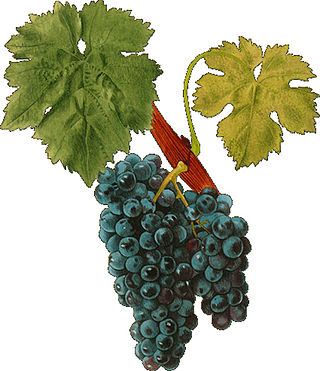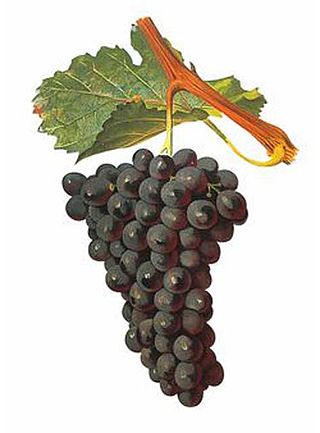
Carignan is a red grape variety of Spanish origin that is more commonly found in French wine but is widely planted throughout the western Mediterranean and around the globe. Along with Aramon, it was considered one of the main grapes responsible for France's wine lake and was a substantial producer in jug wine production in California's Central Valley but in recent years, it has been reborn as a flagship wine for many cellars in the south of France as well as in Catalonia.

Cinsaut or Cinsault is a red wine grape whose heat tolerance and productivity make it important in Languedoc-Roussillon and the former French colonies of Algeria, Lebanon, and Morocco. It is often blended with grapes such as Grenache and Carignan to add softness and bouquet.
Côtes du Roussillon is an Appellation d'Origine Contrôlée for wines made in the Roussillon wine region of France. It is the least selective AOC in the Roussillon region. In 2002, 21,048,500 litres of Côtes du Roussillon were produced, 68% red, 28% rosé and 4% white. Grenache is the dominant variety in Red and Rosé. According to the AOC rules, however, red wines must be made with at least three varieties of grapes. The total of the two main variety grapes should not make more than 90% of the blend, and there must not be more than 60% of Carignan in it.

Châteauneuf-du-Pape is a French wine, an Appellation d'origine contrôlée (AOC) located around the village of Châteauneuf-du-Pape in the Rhône wine region in southeastern France. It is one of the most renowned appellations of the southern part in the Rhône Valley, and its vineyards are located around Châteauneuf-du-Pape and in neighboring villages, Bédarrides, Courthézon and Sorgues, between Avignon and Orange. They cover slightly more than 3,200 hectares or 7,900 acres (32 km2) and produce over 110,000 hectolitres of wine a year, more wine made in this one area of the southern Rhône than in all of the northern Rhône.
Coteaux de Pierrevert is a wine-growing AOC in the western part of the Provence wine region of France, where the wines are produced in 11 communes of the Alpes-de-Haute-Provence département. It is partly located in the valley of the Durance river in the region of Manosque which is the northern part of Provence, it is considered by the INAO however, to be an eastern extremity of the southern Rhône Valley.

Luberon is a French wine-growing AOC in the southeastern extreme of the Rhône wine region of France, where the wines are produced in 36 communes of the Vaucluse département. The neighbouring appellation of Ventoux AOC stretches along its northern border and is separated by the Calavon river. The southern limit of the region is marked by the Durance river.

Languedoc-Roussillon wine, including the vin de pays labeled Vin de Pays d'Oc, is produced in southern France. While "Languedoc" can refer to a specific historic region of France and Northern Catalonia, usage since the 20th century has primarily referred to the northern part of the Languedoc-Roussillon region of France, an area which spans the Mediterranean coastline from the French border with Spain to the region of Provence. The area has around 700,000 acres (2,800 km2) under vines and is the single biggest wine-producing region in the world, being responsible for more than a third of France's total wine production. In 2001, the region produced more wine than the United States.

Terret noir is a dark-skinned French wine grape variety grown primarily in the Rhône valley region of France. It is a mutation of the old Vitis vinifera vine Terret. It is a permitted blending grape for Châteauneuf-du-Pape. Like the related Terret gris and Terret blanc, the vine tends to bud late and grow vigorously. Terret noir produces a light color wine that is perfumed and tart.
Braquet is a red French wine grape variety grown predominantly in the Provence region of southeastern France, particularly in the Bellet Appellation d'origine contrôlée (AOC) where it is as both a blending and varietal grape in still and rosé wines. Also known as Brachet, the vine produces naturally low yields and light bodied wines that are delicately perfumed. Recent thought among ampelographers is that Braquet is not related to the more aromatic Italian wine grape of the Piedmont region known as Brachetto.

Corbières is an Appellation d'origine contrôlée (AOC) for wine in the Languedoc-Roussillon, France, and it is this region's largest AOC, responsible for 46 per cent of the region's AOC wine production in 2005. Red wine dominates the production in Corbières with almost 95 per cent, with 3.5 per cent rosé wine and 2 per cent white wine making up the balance. Carignan is the most common grape variety. The AOC was created in 1985, covers 13,500 hectares of vineyards and produces an average of 554,000 hectoliters of wine per year, corresponding to 74 million bottles.

Costières de Nîmes is an Appellation d'Origine Contrôlée (AOC) for wines that are produced in an area between the ancient city of Nîmes and the western Rhône delta, in the French department of the Gard. Formerly part of the Languedoc region of France, as the wines more resemble those of the Rhône valley in character than of the Languedoc, it is now part of the Rhone wine area and administered by the Rhône Wine committee which has its headquarters in Avignon.

Algerian wine is wine cultivated and bottled in Algeria. It has played an important role in the history of wine. Algeria's viticultural history dates back to its settlement by the Phoenicians and continued under the Roman empire. Prior to the Algerian War of Independence (1954-1962), Algeria was the largest wine exporter in the world, accounting for nearly two-thirds of the total international wine trade.
Baron de Lestac is a Bordeaux wine brand owned by Groupe Castel. Baron de Lestac is produced as a red wine and a white wine, both Bordeaux AOC wines and produced with an influence of oak. The wine is sold in a variety of containers including bottles and bag-in-box.

Bernard Magrez is a French wine magnate who predominantly owns Bordeaux wine estates, including Château La Tour Carnet, Château Pape Clément, Château Fombrauge and Clos Haut-Peyraguey but also a large number of wine producing properties in other French wine regions and other countries, including Spain, Portugal, Chile, Argentina, Japan, Morocco and California. In 2017 it was confirmed that Magrez had bought Château Le Sartre in Bordeaux's Pessac-Léognan.
Malesan is a Bordeaux wine brand owned by Groupe Castel. It is produced as a red, rosé and white wine. Malesan was originally owned by Bernard Magrez, and was bought by Castel in 2003.

Among the countries of North Africa, Morocco is considered to have the best natural potential for producing quality wines, due to its high mountains and the cooling influence of the Atlantic, as these factors offset the risk of having too hot vineyards. An important exporter of wine in the colonial era between 1912 and 1955, the Moroccan wine industry is experiencing a revival and expansion since the 1990s due to influx of foreign investments.

Brun Fourca is a red French wine grape variety that once grew widely throughout Provence and Southwest France but is now limited to small plantings within the Palette Appellation d'Origine Contrôlée (AOC).
Belaire Rosé is a French sparkling wine produced in the Provence-Alpes-Côte d'Azur region of the South of France.
Castel Group is a French beverage company. It was established in 1949 by Pierre Castel, who continues to run the company as a family-owned concern.

Force Majeure is a Washington/Oregon wine estate, specializing in Syrah, Cabernet Sauvignon as well as other Bordeaux and Rhone-inspired blends. The brand was founded in 2004, and beginning with that vintage Force Majeure began the "Collaboration Series" of wines made by some of Washington's top winemakers, using fruit from Red Mountain's Ciel du Cheval vineyard.













